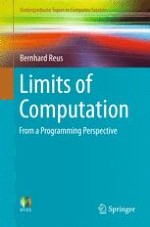2016 | OriginalPaper | Chapter
11. The Church-Turing Thesis
Author : Bernhard Reus
Published in: Limits of Computation
Publisher: Springer International Publishing
Activate our intelligent search to find suitable subject content or patents.
Select sections of text to find matching patents with Artificial Intelligence. powered by
Select sections of text to find additional relevant content using AI-assisted search. powered by
Abstract
WHILE-programs as choice of “effective procedures”. In this chapter we show that they do not depend on this particular choice of WHILE. Various other (well known) notions of computation are formally introduced. This list includes machine languages like Turing machines, random access memory machines and counter machines, for which a program consists of a sequence of labelled instructions, and jumps are the only control flow mechanisms. We also consider a flow chart language and cellular automata. It is then argued, by means of compilation, that all these languages are equally powerful in the sense that anything that can be programmed in one can be also programmed in any other. This provides evidence for the so-called Church-Turing thesis, that all reasonable formalizations of the intuitive notion of effective computability are equivalent.